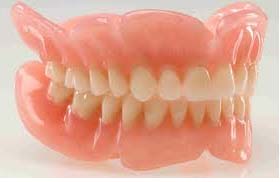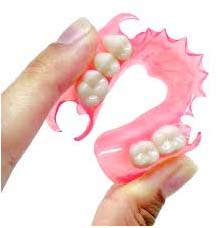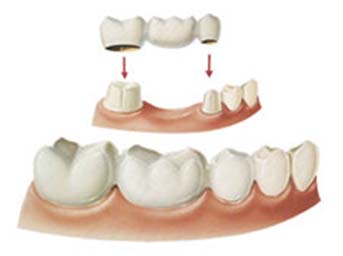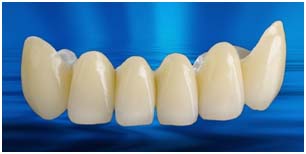Dentures
Removable Dentures
When a person has had all of their teeth removed we must make complete dentures for the person to wear. Dentures are an acceptable solution, but no match for our real teeth! Hence we always try to save natural teeth. When the teeth are removed we are left with a ridge of bone on the upper and lower parts of our mouth,that we can use to put false teeth on.The lower denture always takes a little more work for most patients to get used to for two reasons:lack of height of bone and prescence of the tongue. The tongue increases in size in an edentulous mouth and it resists any new encumberence to its unchallenged domain. In the upper ridge however there are no such interferences.
Advantages
- Long term experience over the years
- Relative low cost
- Predictable results
- Tolerated well by most people
- Restores missing teeth and lost ridge or gums
- Function and appearance is restored
- Aesthetically good where lip and cheek support is inadequate
- Can be fabricated fairly quickly
Disadvantages
- Cause pressure that results in underlying bone resorption and soreness
- Removability- not fixed like natural teeth
- Bulk
- Instability because it is removable and underlying progressive bone resorption
- Looseness as it can only sit atop the gums- especially lowers
- Only low chewing or biting forces can be produced
- Speech problems due to a large appliance in your mouth and it may move
- Taste problems
- Longevity- the need to reline to fit or wearing out
- Covering the roof of the mouth which can result in gagging problems
- Risk of breakage
An important step in maintaining a healthy smile is to replace missing teeth. When teeth are missing, the remaining ones can change position, drifting into the surrounding space. Teeth that are out of position can damage tissues in the mouth. In addition, it may be difficult to clean thoroughly between crooked teeth. As a result, you run the risk of tooth decay and periodontal (gum) disease, which can lead to the loss of additional teeth. In situations where only some teeth are missing we can also use a Removable Partial Denture.
A removable partial denture fills in the space created by missing teeth and fills out your smile.It is usually used when the space without teeth is too large for a bridge,or there are no teeth on either side of the gap or for economic reasons.The partial denture locks into place with its metal clasps.A denture helps you to properly chew food, a difficult task when you are missing teeth. In addition, a denture may improve speech and prevent a sagging face by providing support for lips and cheeks. There are two types of these:ones made fully of plastic(acrylic) or ones having a metal framework for rigidity and the teeth are the same kind used in full dentures.The latter ones are called CAST partial dentures and are much better and expensive.
These particular partials replace some upper teeth. The metal you see will fit across part of the palate.
INSTRUCTIONS FOR PATIENTS WITH DENTURES
You’ve just received your new dentures. whether you’re a seasoned veteran or a new denture wearer, we’re sure there are many questions which may need to be answered. We hope that the following information will prove to be helpful during the next few weeks of your denture adjustment period.
- Learning to wear a new denture can take time.Don’t become discouraged if you find some difficulty in the beginning. YOU’RE NOT ALONE! Your dentist will help you through any difficulties you may face or any situations that may arise during your adjustment period.
- A lower denture usually takes more time to adjust to than an upper denture.The tongue may feel restricted and will tend to play, sometimes even subconsciously, with the new prosthesis. It will soon adapt to the restrictions and to the new feeling that a denture presents.
- It is natural to experience fullness of the mouth with new dentures. Expect to have excessive flow of saliva. At first you will have a feeling of looseness, especially the lower denture. You will adjust to it.
- Try to eat only soft foods for the first couple of days. Then, as you progress to more solid foods try to eat slowly and deliberately, attempting to place even amounts of food on both sides at the same time during the chewing cycle. By placing food on both sides of the mouth at the same time, you balance the biting forces on the new denture and will help to make it more stable.The longer you take to eat your meal, the faster you will learn to master your new prosthesis.
- Try to take small bites at first. Cut all your food into small portions. If, and when, your gum tissues are strong enough to try foods which are bitten off (bread, corn on the cob, etc. try to press the food against the back teeth on the upper in order to stabilize the denture.
- It is perfectly normal to experience some discomfort associated with sore spots during the adjustment period. Nature did not intend for us to wear hard plastic against soft gum tissue. It takes a while for the gum tissues to firm up and to accommodate to the hard plastic denture.
- If sore spots should develop (and in some cases they do not), please be sure to wear the denture for at least 24 hours prior to your adjustment visit!If your dentist can’t see the sore spot visually, it is sometimes impossible for him to make the necessary adjustments.
- Reading aloud during the first couple of days will go a long way in reducing any minor speech problems which may result from wearing a new denture. If speech problems continue to persist, please let your dentist know.
- An unclean denture is neither healthy, attractive or comfortable. Clean you new denture every morning and night with either a denture toothbrush and denture toothpaste ( if necessary, any toothpaste can be used ) or with one of the commercially available denture cleaners or soak them overnight in baking soda and water. Please be sure to check with your dentist to make sure that the commercial cleaner will not interfere with the type of denture liner you may have in your prosthesis. Permanent soft liners and temporary soft liners react poorly to most commercial cleaners.
- We prefer that you leave out both of your dentures at night. This allows your gum tissues to breathe and also relieves them of the constant pressures of mastication. When left out of the mouth, all dentures should be left in water to prevent warpage.
- Using excessive amounts of denture adhesive to retain ill-fitting dentures invites serious problems and more involved correction at a later date.
- Gum tissues are in a constant state of changebut dentures are not. Therefore, periodic relining of your dentures may be necessary. If you find your denture getting looser and mastication more difficult, this may be a sign that a reline may be needed. It is very important for your dentist to see you regularly to evaluate the state of your oral tissues and to determine if additional treatment is required. Dentures typically need to be relined or remade every 3-5 years.
- NEVERtry to adjust your dentures yourself ! Home remedies, although simple, will only lead to trouble.
- If any problems arise or if you have any additional questions, your dentist is available to help.
Semi- Flexible removable partial denture.
is an aesthetically superior semi-flexible removable partial denture which blends perfectly with the natural gum tissue providing better function and comfort.
Benefits at a glance
- Comfortable, durable and stronger
- Has the perfect degree of flexibility (semi flexible)
- Non-Invasive so minimal discomfort
- No metal clasps – only tissue-colored clasps that blend with gums
- Unbreakable
- More stain-resistant than other flexible acrylics
- Monomer Free and manufactured using injection molding system
- Suitable for combination works ( with Cast partials)
Available in three different shades; soft pink, dark pink and intense pink.
Crown & Bridges
All Ceramic (Metal Free)
Ceramics are now referred to as the “white gold” in dental practices and dental laboratories. Dental professionals now have a selection of extremely strong ceramic materials at their disposal. Zirconium Oxide, Lithium Disilicate and Yttrium-stabilized Zirconium Oxide are clinically proven and considered to be superior.
The mechanical properties of these ceramics exceed even those of noble materials. It is extremely bio-compatible and can be used to fabricate a restoration that appears absolutely natural. Its color, vitality and dynamic light properties are particularly important for the anterior regions of dentition.
Ceramics in implant – supported prosthesis is a great leap forward. These prefabricated and customizable abutments completely go without a metal base.
If something unfortunate happens to your teeth, it is important to consult Prosthodontist, to minimize the impact on your entire mouth. Missing teeth can allow the surrounding teeth to become displaced. Cracked or damaged teeth should be fixed to save as much of the tooth as possible.
By taking care of dental problems immediately, you minimize the risk of future problems.
- Crowns fix and protect teeth that are so damaged or diseased that they need more support than a simple filling.
- Bridges replace missing teeth and offer support for the surrounding teeth to help retain the integrity of the jaw and face structure.
Dental Crowns
Crowns, also known as caps, restore damaged teeth and mimics the shape, size and color of the surrounding teeth. Crowns are indicated for cracked teeth and teeth with deep cavities; to protect teeth that have been filled by root-canal treatment; to provide extra support for bridges; and to cover poorly shaped or discolored teeth. Crowns may be made of metal, porcelain, or newer restorative materials like metal free ceramics. They are custom-made and fitted for each patient in conformation with the size and length of the natural teeth. Crowns typically last five to eight years, but can last much longer with proper oral hygiene. Crowns can be made of a variety of materials. They can be made of plastic, ceramic or metal alloys. A combination of metal and ceramic is also possible to maximize strength and simulate the appearance of natural teeth.
The teeth to be crowned are prepared which involves reduction of the tooth size (usually under local anaesthesia) followed by an impression or mould of the prepared tooth. This trimming of the tooth is required to create space for the crown to be fitted. The mould taken is then sent to a laboratory where skilled technicians will fabricate the crown. In the meanwhile, a temporary crown is made and fitted onto the trimmed tooth.
Dental Bridges
A bridge stabilizes the bite of a patient who is missing one or more teeth. Bridges prevent the surrounding teeth from moving or shifting in the mouth. A missing tooth that is not replaced may cause surrounding teeth to become unstable and require removal, compromising oral health or change the shape of the face and diminish the beauty of a smile.
Unlike partial dentures, bridges are FIXED patients need not remove them. The missing tooth is replaced with an artificial tooth connected between two crowns (caps), which are permanently cemented or bonded on the adjacent teeth.
Bridges can be used to replace a small number of missing teeth if the neighboring teeth are sufficiently strong. The number of missing teeth, condition of the neighboring teeth, condition of the supporting gums and bone are all important factors which need to be assessed prior to making a bridge.





